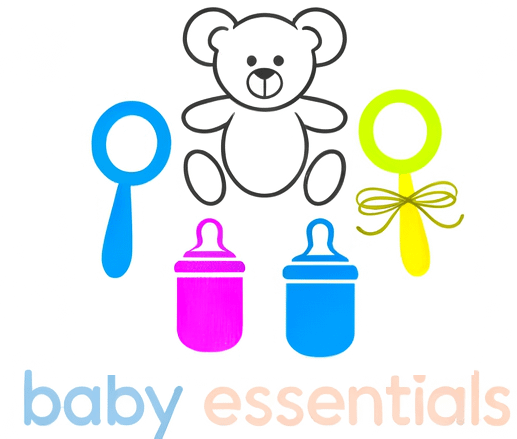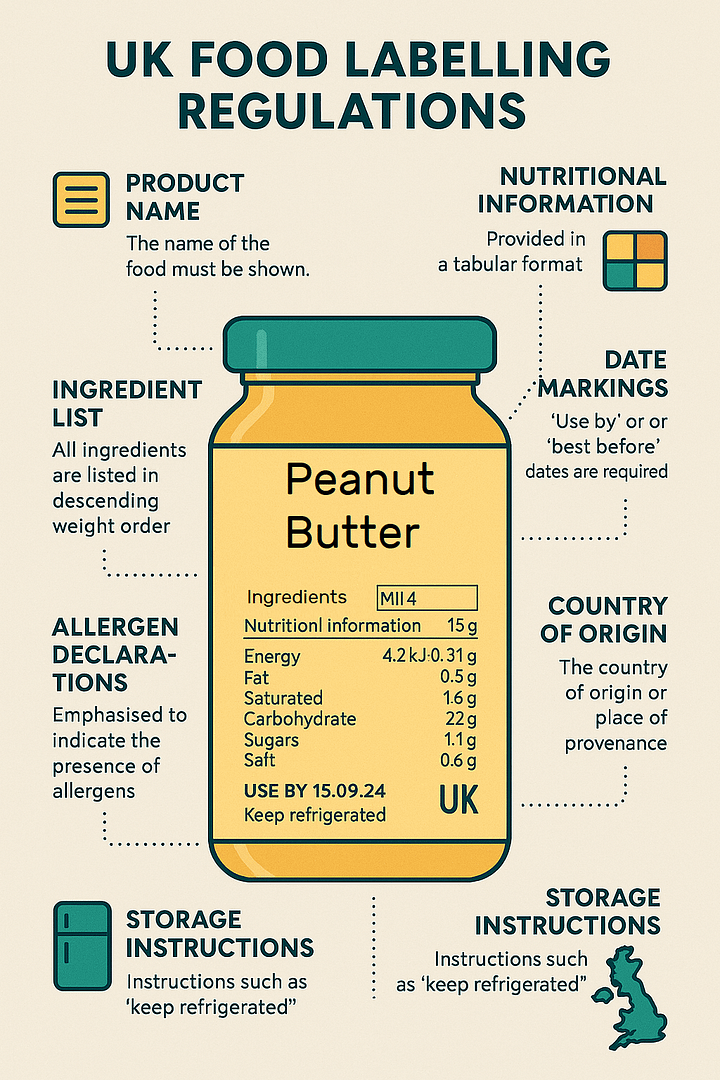Introduction to Understanding UK Food Labelling Regulations
UK food labelling regulations serve as essential safeguards that ensure transparency and safety throughout the food supply chain. These comprehensive laws provide consumers with vital information about food contents and quality, enabling informed purchasing decisions. This guide examines the key regulatory requirements and their practical implications for both consumers and food manufacturers.
Understanding UK Food Labelling Regulations – The Legal Framework
The Food Information Regulations 2014 establish the primary legal foundation for food labelling requirements in the UK. This legislation creates a standardised framework that helps consumers understand product contents while promoting food safety and industry transparency. The regulations mandate specific information that must appear on all food labels, ensuring consistency across the marketplace.
Mandatory Label Components
Product Name
Every food product must display a clear, accurate name that reflects its true nature. The product name cannot be misleading and must help consumers understand exactly what they are purchasing. For example, a “fruit spread” must contain the appropriate percentage of actual fruit content as defined by regulations.
Ingredient Lists
All ingredients must be listed in descending order by weight, with the heaviest ingredient appearing first. This requirement serves multiple purposes: it enables quick identification of primary ingredients, assists consumers with dietary restrictions, provides transparency about product composition, and helps identify potential allergens or unwanted additives.
Allergen Information
UK law requires clear highlighting of 14 major allergens on food labels: celery, cereals containing gluten, crustaceans, eggs, fish, lupin, milk, molluscs, mustard, peanuts, sesame, soybeans, sulphur dioxide and sulphites, and tree nuts. These allergens must be emphasised through bold text or other clear formatting to minimise the risk of accidental consumption by sensitive individuals.
Nutritional Information
Labels must display standardised nutritional data, typically showing values per 100 grams or per serving. Required information includes energy content (calories), total fat and saturated fat, carbohydrates and sugars, protein content, and salt levels. This standardisation enables effective product comparison and supports informed dietary choices.
Date Markings
Two distinct types of date markings provide different safety and quality information. “Use By” Dates indicate the final date for safe consumption, as products should not be consumed after this date, as they may pose health risks. “Best Before” Dates relate to quality rather than safety, showing when products may begin losing optimal taste or texture. Many items remain safe to consume after this date, though quality may decline.
Storage Instructions
Labels must include appropriate storage conditions to maintain product safety and quality. Common examples include “refrigerate after opening,” “store in a cool, dry place,” or “keep frozen until use.” Proper storage guidance helps prevent spoilage and maintains food safety.
Country of Origin
Current regulations require clear identification of where food products originate. This transparency supports consumer decision-making, particularly for those concerned with sustainability, environmental impact, or supporting local producers.
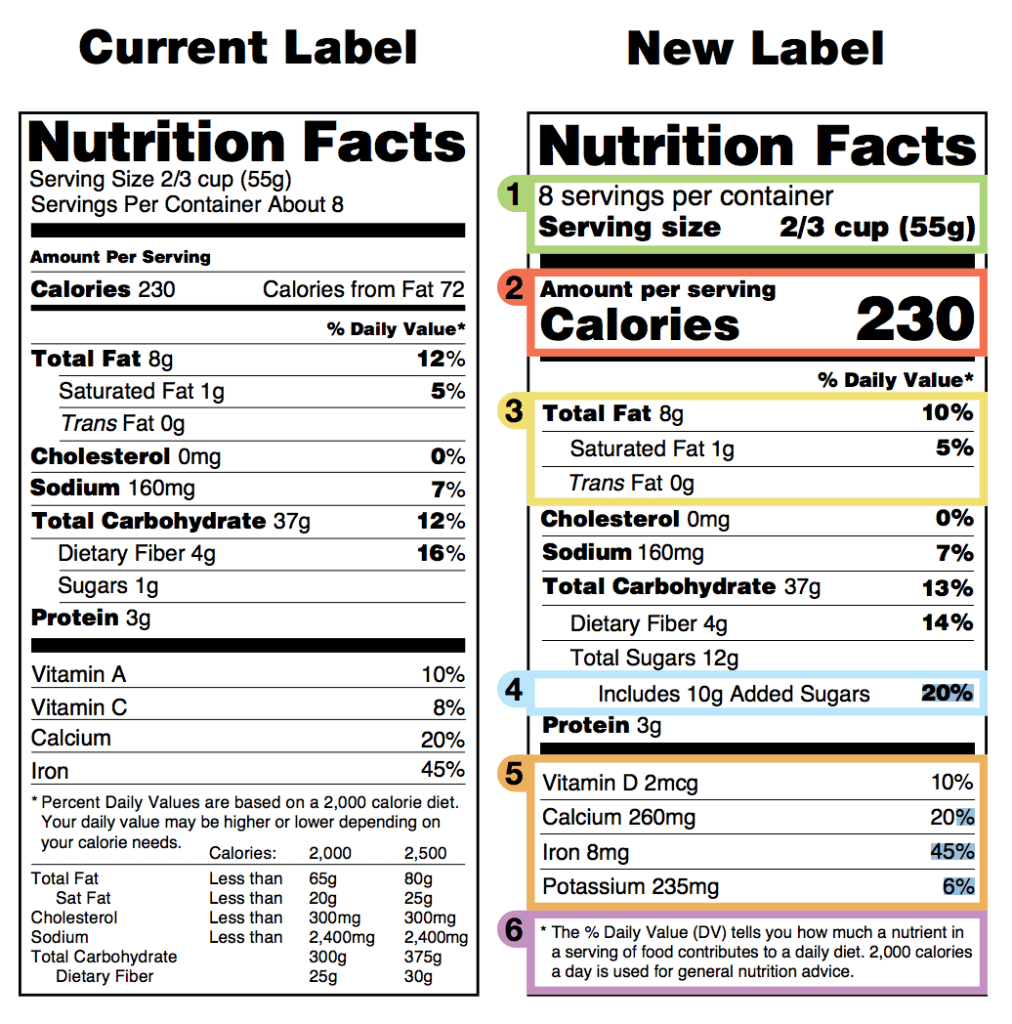
Nutrition Labelling Systems
Traffic Light System
The UK employs a colour-coded traffic light system that categorises products as green (low), amber (medium), or red (high) for fat, saturated fat, sugars, and salt. This visual system simplifies nutritional assessment and promotes healthier food choices.
Nutritional Claims
Claims such as “high in fibre,” “low fat,” or “reduced sugar” must meet specific regulatory criteria. Terms like “organic,” “natural,” or “wholesome” require strict compliance with defined standards to prevent consumer deception. Proper regulation ensures these claims provide meaningful, trustworthy information.
Current Challenges
Online Sales Compliance
The growth of e-commerce has created new enforcement challenges. Online platforms may not adequately display essential labelling information that consumers would typically see in physical stores. Third-party vendors can sometimes sell non-compliant products without sufficient oversight, making regulatory monitoring more difficult.
Technological Integration
Future developments may incorporate QR codes linking to detailed product information, blockchain technology for enhanced traceability, real-time updates for product recalls or ingredient changes, and mobile applications for instant nutritional analysis.
Sustainability Requirements
Growing consumer demand for environmental information may drive new labelling requirements covering carbon footprint data, animal welfare certifications, ethical sourcing practices, and packaging sustainability information.
International Standards
As the UK maintains global trade relationships, harmonising national regulations with international standards remains crucial. This balance ensures consumer protection while facilitating international commerce.
Benefits for Consumers and Industry
Consumer Empowerment
Clear labelling enables consumers to make informed dietary choices, avoid allergens and unwanted ingredients, compare products effectively, understand nutritional content, and support ethical and sustainable practices.
Industry Accountability
Regulations ensure manufacturers maintain transparency in product composition, meet safety and quality standards, provide accurate nutritional information, comply with ethical labelling practices, and build consumer trust through honest communication.
Conclusion
UK food labelling regulations represent a comprehensive framework designed to protect consumers through transparency and accurate information provision. From mandatory product identification to detailed nutritional data, each component serves a vital role in promoting food safety and enabling informed consumer choice. As the food industry continues evolving with changing consumer preferences and technological advances, these regulations must remain adaptive while maintaining their core purpose of consumer protection. Understanding these requirements empowers both consumers to make better choices and manufacturers to maintain compliance with essential safety and transparency standards.
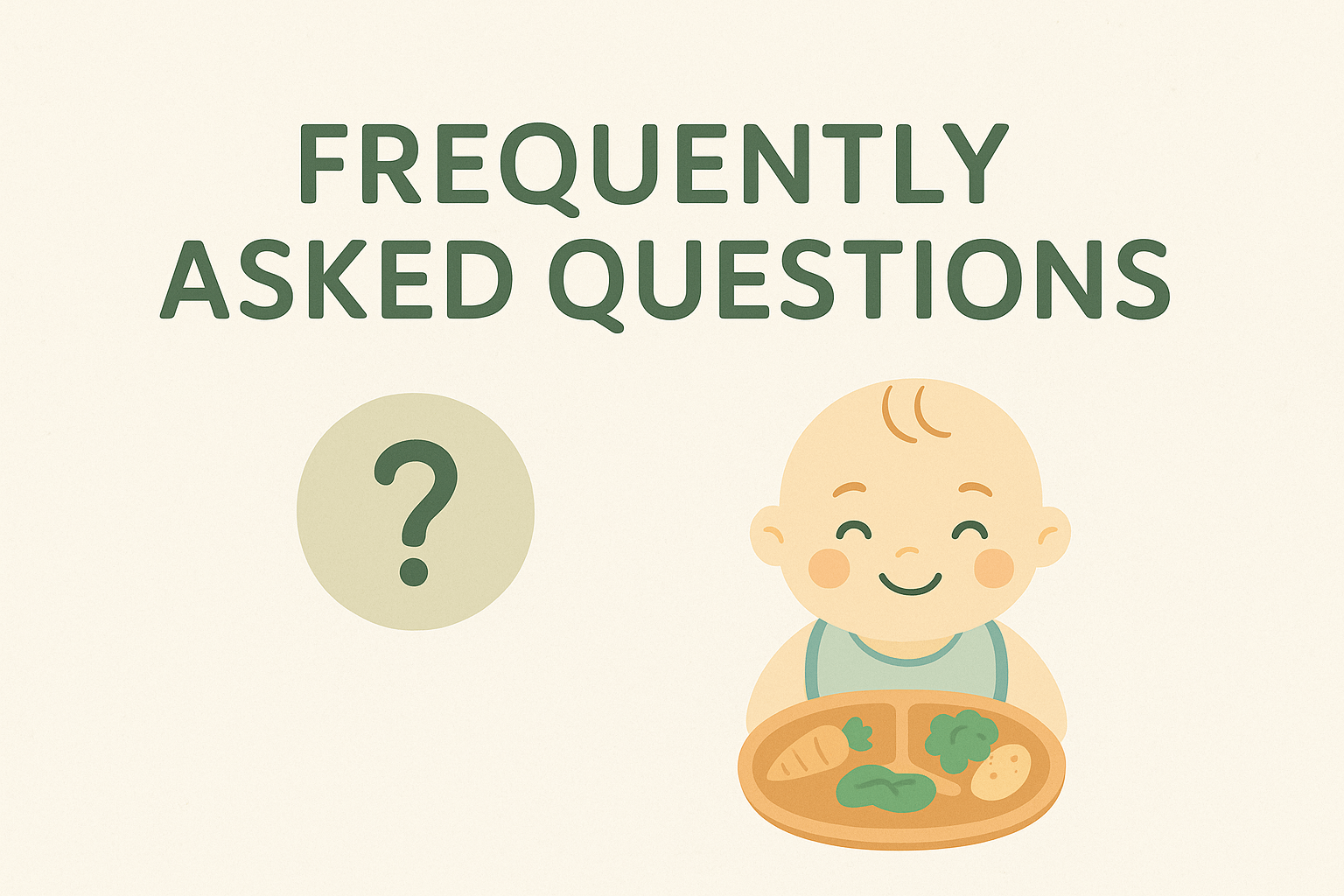
Frequently Asked Questions About UK Food Labelling Regulations
What are the 14 major allergens that must be highlighted on UK food labels?
UK law requires clear highlighting of 14 major allergens: celery, cereals containing gluten, crustaceans, eggs, fish, lupin, milk, molluscs, mustard, peanuts, sesame, soybeans, sulphur dioxide and sulphites, and tree nuts. These must be emphasised through bold text or other clear formatting to help consumers with allergies identify potential risks quickly.
What’s the difference between “use by” and “best before” dates?
“Use by” dates indicate the final date for safe consumption – products should not be eaten after this date as they may pose health risks. “Best before” dates relate to quality rather than safety, showing when products may begin losing optimal taste or texture. Many items remain safe to consume after the “best before” date, though quality may decline.
How should ingredients be listed on food labels?
All ingredients must be listed in descending order by weight, with the heaviest ingredient appearing first. This enables consumers to quickly identify primary ingredients, assists those with dietary restrictions, and provides transparency about product composition. Allergens within the ingredient list must be clearly highlighted.
What is the UK traffic light labelling system?
The UK traffic light system uses colour-coding to categorise products as green (low), amber (medium), or red (high) for fat, saturated fat, sugars, and salt content. This visual system simplifies nutritional assessment and helps consumers quickly identify healthier options when comparing products.
Are nutritional claims like “low fat” or “organic” regulated?
Yes, claims such as “high in fibre,” “low fat,” or “organic” must meet specific regulatory criteria defined by UK law. These claims cannot be misleading and must be substantiated by evidence. Terms like “natural” or “wholesome” require strict compliance with defined standards to prevent consumer deception.
What challenges do online food sales create for labelling compliance?
Online platforms may not adequately display essential labelling information that consumers would typically see in physical stores. Third-party vendors can sometimes sell non-compliant products without sufficient oversight, making regulatory monitoring more difficult. This creates challenges for ensuring consumers receive all necessary product information when shopping online.
Why is country of origin labelling now required in the UK?
Country of origin labelling provides transparency about where food products come from, supporting informed consumer decision-making. This is particularly important for consumers concerned with sustainability, environmental impact, supporting local producers, or understanding supply chain practices. It helps consumers make choices aligned with their values and preferences.
Food Tables and Labelling
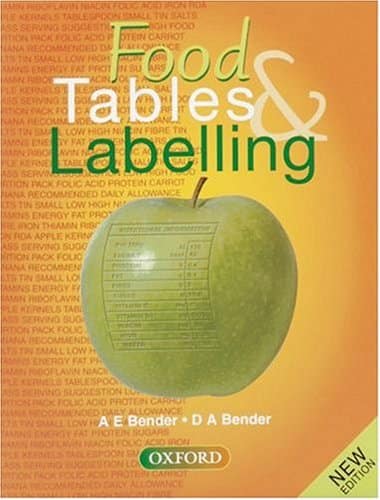
Disclosure: As an Amazon Associate, I earn from qualifying purchases. This means that if you click on a link and make a purchase, I may receive a small commission at no additional cost to you.
Further Reading
- Understanding Common Food Allergens and Their Impact
- Avoiding Choking Hazards During Feeding
- Exploring Baby-Led Weaning and Traditional Spoon-Feeding
- Baby Food Allergies: Symptoms and Prevention
- Introducing Solid Foods: A Month-by-Month Guide
Understanding UK Food Labelling Regulations Podcast
As the podcast is hosted on Spotify, you may need to refresh the page to pull in the podcast.
References and Sources for UK Food Labelling Regulations
Primary Legislation and Government Sources
Food Standards Agency (FSA)
- Packaging and labelling guidance – Official FSA business guidance covering legal requirements for food labelling and packaging
- Website: food.gov.uk/business-guidance/packaging-and-labelling
- Last Updated: September 4, 2023
UK Government Official Guidance
- Food labelling and packaging: Food labelling – what you must show – Comprehensive government guidance on mandatory labelling requirements
- Website: gov.uk/food-labelling-and-packaging/food-labelling-what-you-must-show
- Last Updated: December 4, 2014
- Food labelling and packaging: Overview – General overview of UK food labelling regulations
- Website: gov.uk/food-labelling-and-packaging
- Last Updated: December 4, 2014
Key Legislation
The Food Information Regulations 2014
- Primary UK legislation governing food labelling requirements
- Retained EU law based on Regulation (EU) No 1169/2011 on the provision of food information to consumers
- Covers mandatory labelling requirements, allergen declarations, and nutritional information
Regulation (EU) No 1169/2011 – Food Information to Consumers (FIC)
- Original EU legislation that forms the basis of UK food labelling law
- Harmonised EU rules on general food labelling and nutrition labelling
Specialist Industry Sources
Campden BRI
- Allergen labelling white paper – Technical guidance on allergen labelling requirements
- Author: Helen Arrowsmith, Principal Food Law Adviser and Allergen Specialist
- Website: campdenbri.co.uk/white-papers/allergen-labelling.php
- Date: August 24, 2023
Food Label Maker
- UK Back-of-Pack Nutrition Labelling Requirements – Detailed guide to nutrition labelling post-Brexit
- Website: foodlabelmaker.com/regulatory-hub/uk/back-of-pack-labels/
- Date: October 3, 2024
Educational and Training Resources
Care Learning
- What are the Food Information Regulations 2014? – Educational overview of FIR requirements
- Website: carelearning.org.uk/blog/food-safety/what-are-the-food-information-regulations-2014/
- Date: March 11, 2025
Ashbury Global
- Food Labelling Regulations UK: A Complete Guide – Comprehensive business guide to UK food labelling
- Website: ashbury.global/blog/food-labelling-regulations-uk/
- Date: January 19, 2024
